Send Frequency: What “Just Right” Looks Like, Vertical by Vertical
Published on December 12, 2020/Last edited on December 12, 2020/15 min read
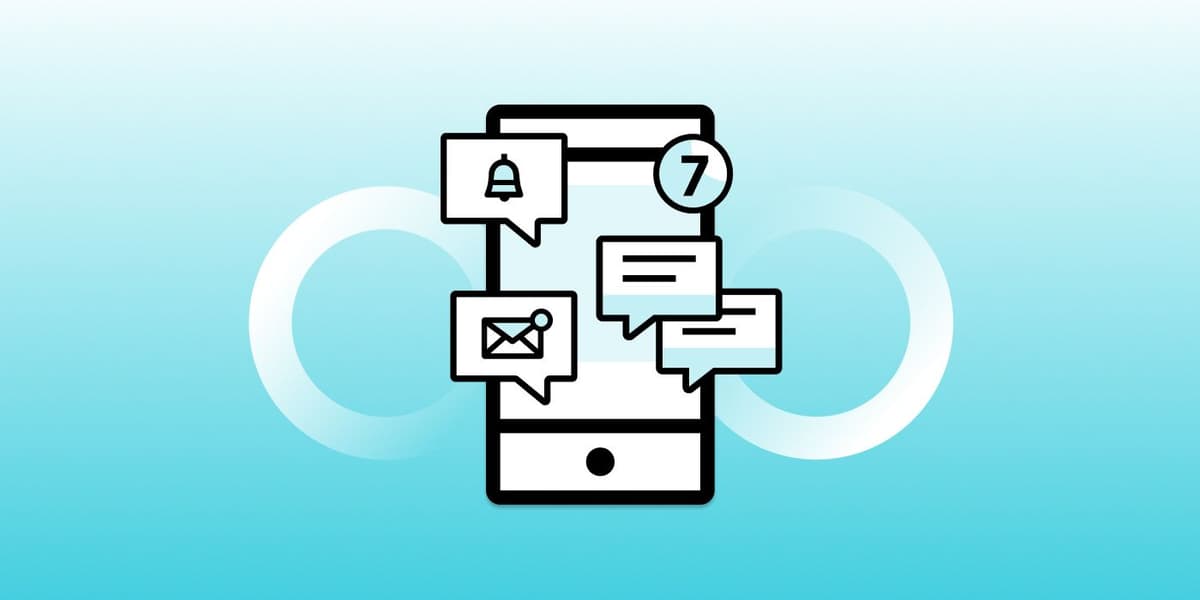

Anna Mongillo
Business Intelligence Analyst at BrazeDuring 2020, Braze sent more than a trillion messages on behalf of customers, giving us a unique window into how send frequency can impact results. In that spirit, we offer these analyses as a starting point for your brand's own frequency testing and optimization work, rather than as a one-size-fits-all optimal benchmark that all brands should match. Remember that many factors can influence frequency, including the use of behavioral and transactional triggers, the segments a given user belongs to (for instance, more engaged customers may be open to more messages), the way a given audience is split within an industry, and the specific messaging strategies a particular brand is using.
Strong customer/brand relationships are built on thoughtful communication. And to make that happen, you have to know your users: What they’re interested in hearing about, when they want to hear it, and—most importantly—how often they expect to hear from you.
That last bit? It’s called send frequency—or the number of messages a brand sends to a given user within a certain period of time. Send frequency is part of marketing pressure, and it’s a critical component of every brand’s marketing efforts. Nobody likes to be blasted with messages (or ignored, for that matter) so knowing what the optimal send frequency is for your users is a powerful way to engage and convert them while being considerate of their time and attention.
So, Am I Sending the Right Number of Messages?
The right send frequency will drive more app opens, revenue, and conversions. If you’re seeing underwhelming engagement or higher-than-expected uninstalls or unsubscribes, you may be sending too many messages, scaring away valuable users. By the same token, you might be sending too few messages, missing out on opportunities to engage further. (That said, sometimes it’s not about frequency at all—in those situations, it’s wise to take a hard look at the content of your messages and whether they’re adding value for your user base.)
It can be hard for brands to know where to start when it comes to optimizing send frequency. That’s why we analyzed our Braze customer data to uncover aggregated industry benchmarks for send frequency. The result? Actionable metrics around the impact of frequency capping on customer engagement. So, let’s dig in!
Send Frequency, By the Numbers
To start out, Braze calculated the optimal frequency for all brands. Braze defines the optimal frequency as that which yields the high engagement, specifically:
- Push-to-app direct and total open rates: The monthly push volume that results in the most app opens attributed to push messages.
- Email open and click rates: The monthly email volume that results in the best email open and click rates.
- Conversion rates: The monthly cross-channel message volume that results in the highest conversion rates.
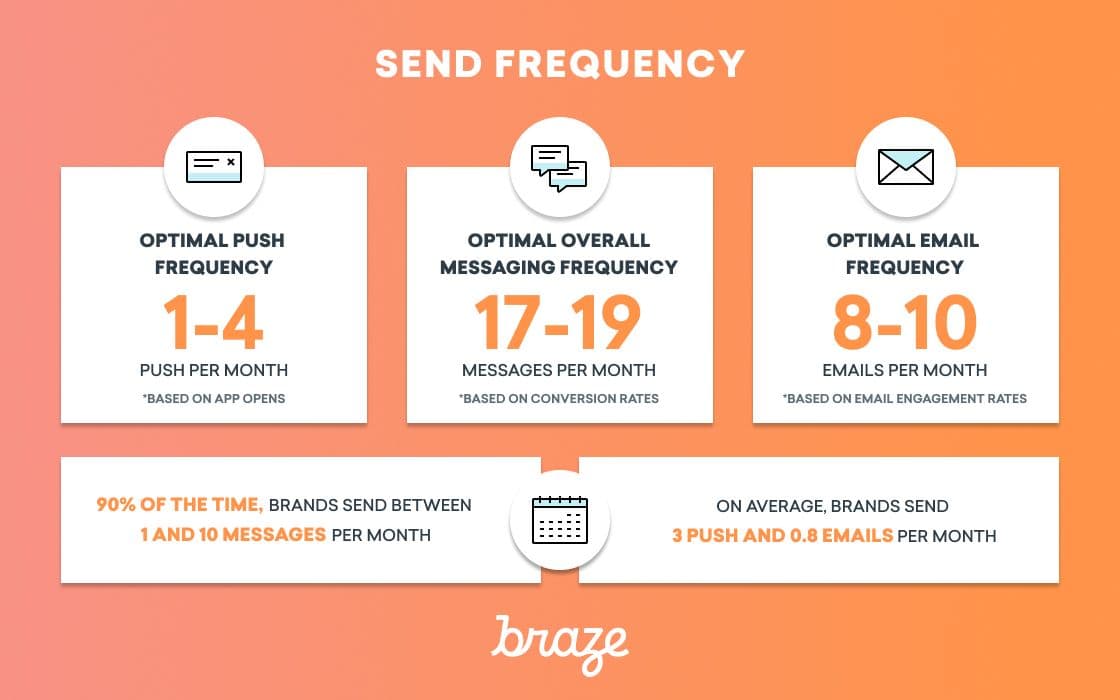
It can be difficult to parse out accurate, functional information from benchmarks data—especially when that data is industry-agnostic. So we decided to take a deeper dive into what the optimal send frequency looks like across 13 major industries: Retail, ecommerce, entertainment, travel, restaurants, delivery services, transportation, finance, health, lifestyle, games, education, and technology. These industry benchmarks can be used as a baseline for determining where your sending strategy falls relative to industry standards. But as you know, your brand isn’t an industry, it’s a business; you can’t assume that your audience and the overall audience for your vertical are identical.
Given that, you’ll want to perform your own analyses in order to accurately gauge user preferences and the success of your sending strategy. You can A/B test on campaign copy and editorial, frequency, timing and cadence, and user segmentation—separately, as well as in tandem. And always, always optimize and iterate on your sending strategy to meet the standards of a continuously changing benchmark. Assume that your users are always changing, because they are. They’re people, after all!
Now, let’s dig into all that data.
Industry #1: Multichannel Retail
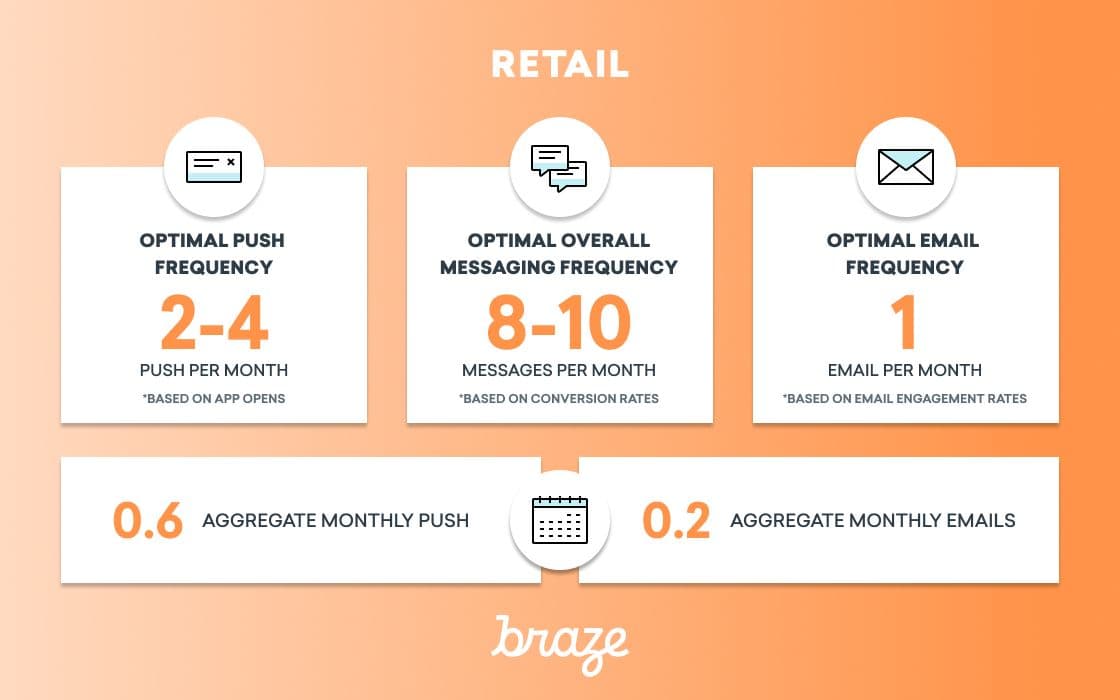
Retailers should personalize push—and exercise email caution
Customer loyalty has long been a key priority for retail brands—and in the current digital marketing landscape, loyalty and customer experience (CX) are arguably indivisible. That means it’s more important than ever before for retail brands to construct smooth, engaging user experiences and message customers when, where, and how they prefer.
Push is currently gaining steam in the retail world, with smartphone shopping expected to grow almost 38% this year. So while you’re striving to hit the optimal push frequency benchmark of 2-4 monthly push notifications per user, consider leveraging advanced push techniques like geolocation-based campaigns and personalized retail experiences to add real value to your messages and help them stand out in your users’ crowded notification centers.
When it comes to email, the data suggests that retailers are not using this channel enough—but that they should be cautious about adding too many more messages to the mix. Retail brands tend to send less than the one email per user each month that constitutes optimal frequency in this channel. Depending on what your brand is looking to do (increase open rates, boost app engagement, or drive more conversions, for instance), getting closer to that magic number is probably wise. But make sure to test before raising your email rates too much; sometimes send frequencies are low because that’s what a given brand’s users prefer.
Industry #2: Ecommerce
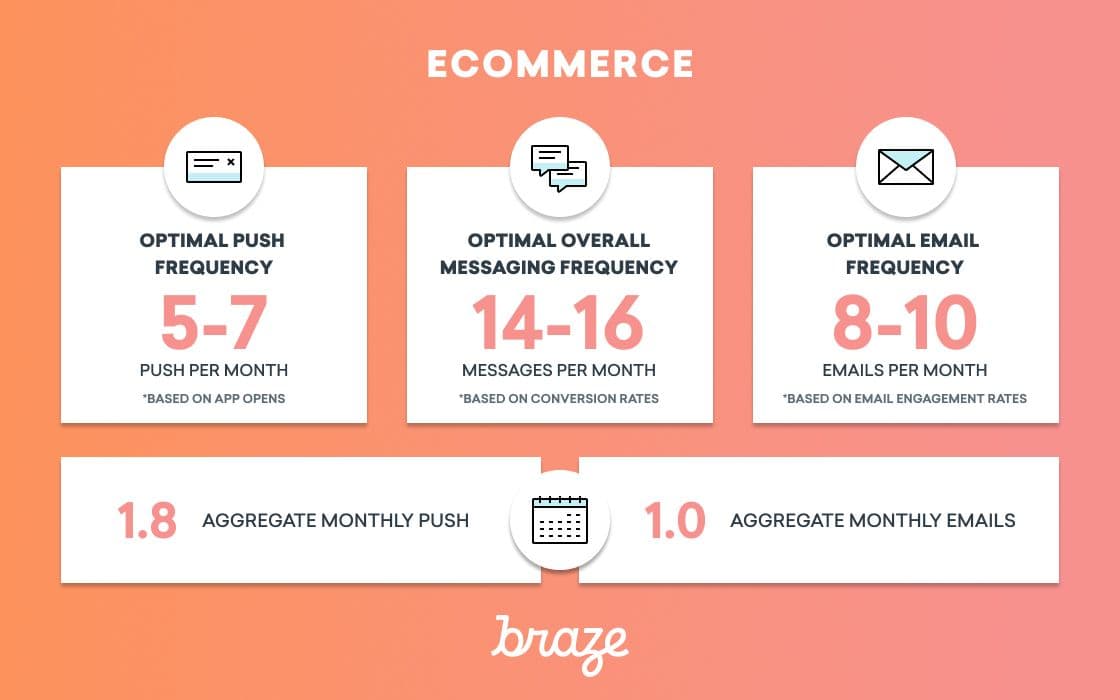
For eCommerce brands, more push messages won’t hurt during the holidays
On average, ecommerce brands send around 1.5 push notifications per month—but app engagement peaks when brands in this space send five to seven pushes. These brands should experiment with sending more messages in this channel, especially as the holidays roll around. They’ll be able to take advantage of a wide variety of ecommerce-ready holiday marketing tactics (such as loyalty program enrollment, referral promotions, or holiday point accelerators) in the coming months. When it comes to email, the data shows a steady increase in user engagement as send volume rises, peaking at around 8-10 emails. These brands are sending a decent amount of email, hitting as high as 13 per month in some cases. But overall, sending each user 14-16 total cross-channel messages per month sees the highest conversion rates, so find the right balance for your audience based on your team’s KPIs.
Industry #3: Entertainment
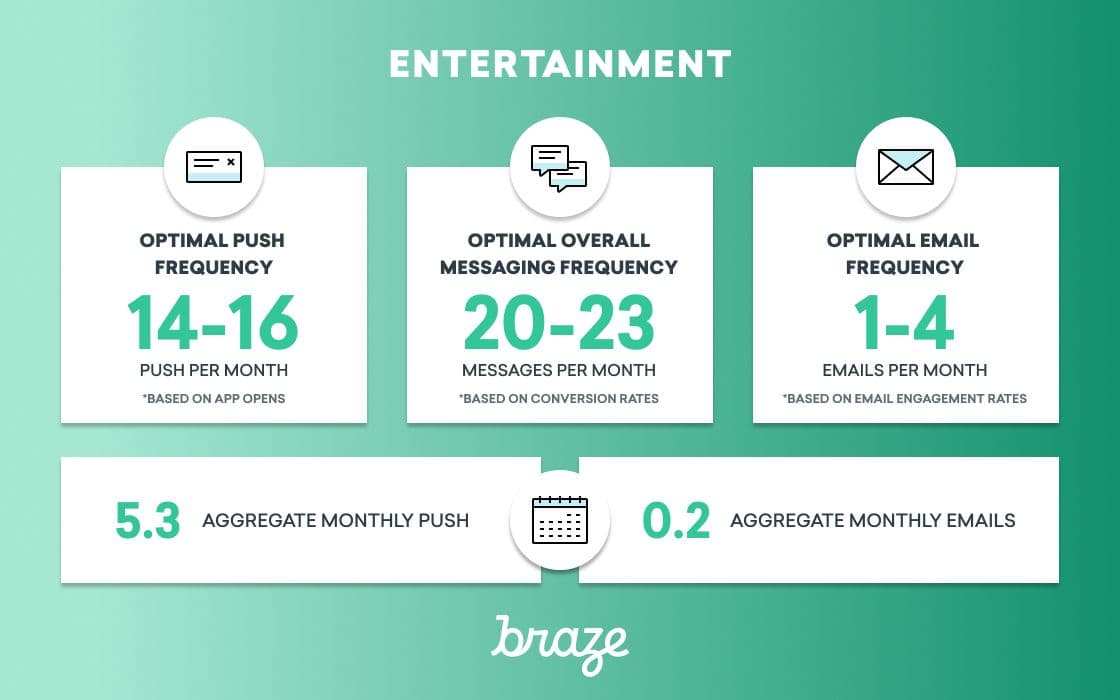
Consumers consume A LOT of content—and entertainment brands respond with lots of messaging.
Entertainment brands, on the other hand, send a lot of push notifications. Our research has found that these companies see peak engagement at around 14-16 push notifications per month—that’s ~5 messages per week! Keep in mind, though, that there’s little value in sending a message just to send it; if it’s not relevant and valuable to recipients, you’re probably better holding off. If you’re in this space and sending at a lower volume, the average push frequency of 5.3 per month may be a better starting point. By testing out various frequencies in that range and scaling up if it makes sense, you can determine if the industry average or the industry optimal range makes more sense for your brand.
On the email front, good news: The majority of entertainment brands are already sending messages in this channel at the optimal frequency of up to four emails per month—right on track for driving engagement.
Industry #4: Travel
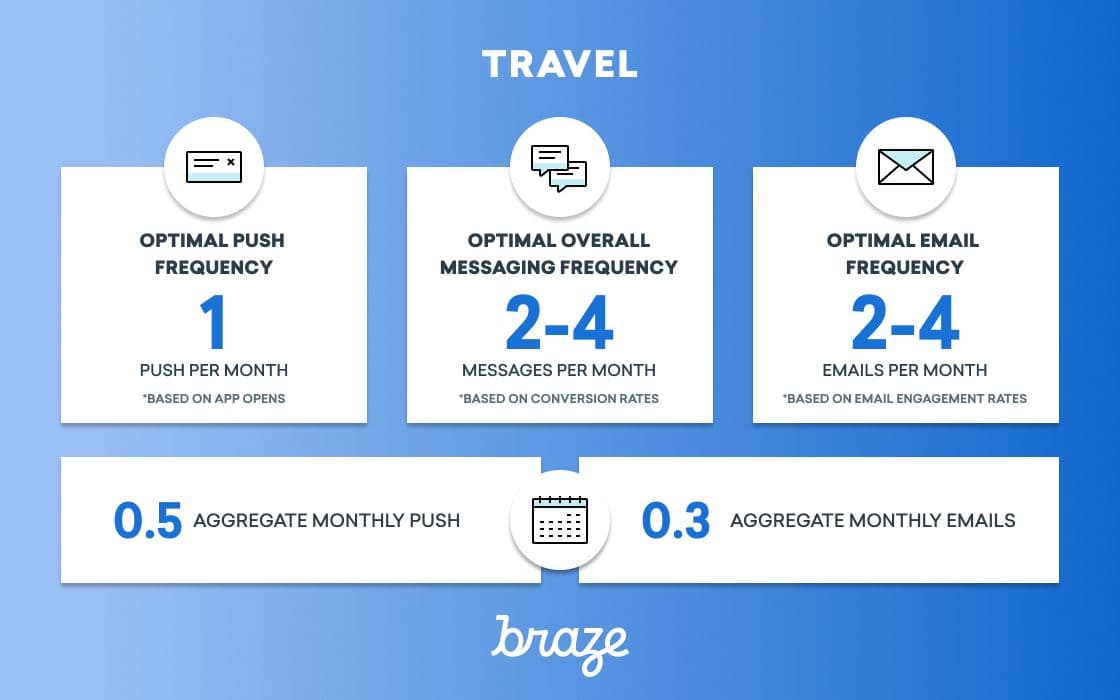
For travel brands, there’s some room to grow
Even though there are tremendous opportunities here to drive user engagement—from onboarding and location-triggered messages to abandoned purchase and re-engagement campaigns, to name just a few—most travel brands send less than one push per month. The upshot? There’s some room for growth with this channel. For a little inspiration, check out some great examples of how travel brands are successfully using push to keep their audiences engagement during (and between trips).
For email, our research found that 2-4 monthly emails per user sees the strongest engagement—but that 88% of brands are sending less than that. With 66% of travel revenue still coming from desktop, email is probably the best channel for driving incremental revenue for travel brands. If your company is in this space, consider sending pre-arrival emails or post-purchase confirmations to boost brand trust and loyalty.
Industry #5: Restaurants
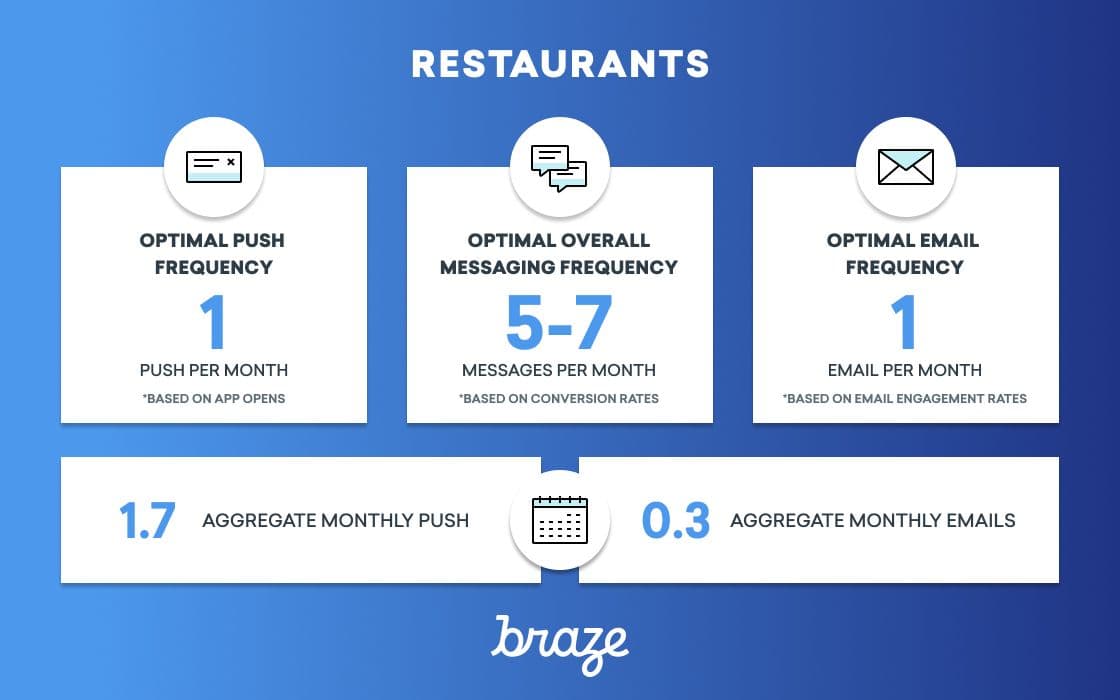
Restaurants don’t send many messages—so they need to send at the perfect times
Braze research shows that restaurants tend to connect with customers via push or email pretty infrequently. Over 70% of brands send no more than one push per person each month, and 90% send one or fewer emails per month to each customer. First, that means restaurants may be missing out on a chance to connect more with their users. And, second, it means that it may be more important for restaurant brands to optimize their messaging than it is to reach out to customers more often. Either way, hitting users’ devices at the right time is going to be key—reaching out in the window when many consumers are thinking over their food options can be an effective way to drive more purchases. That could mean using Intelligent Timing to send outreach when they’re most likely to engage, or leveraging location marketing tools to ping them with notifications when they pass by one of your brick-and-mortar locations.
Industry #6: Delivery Services
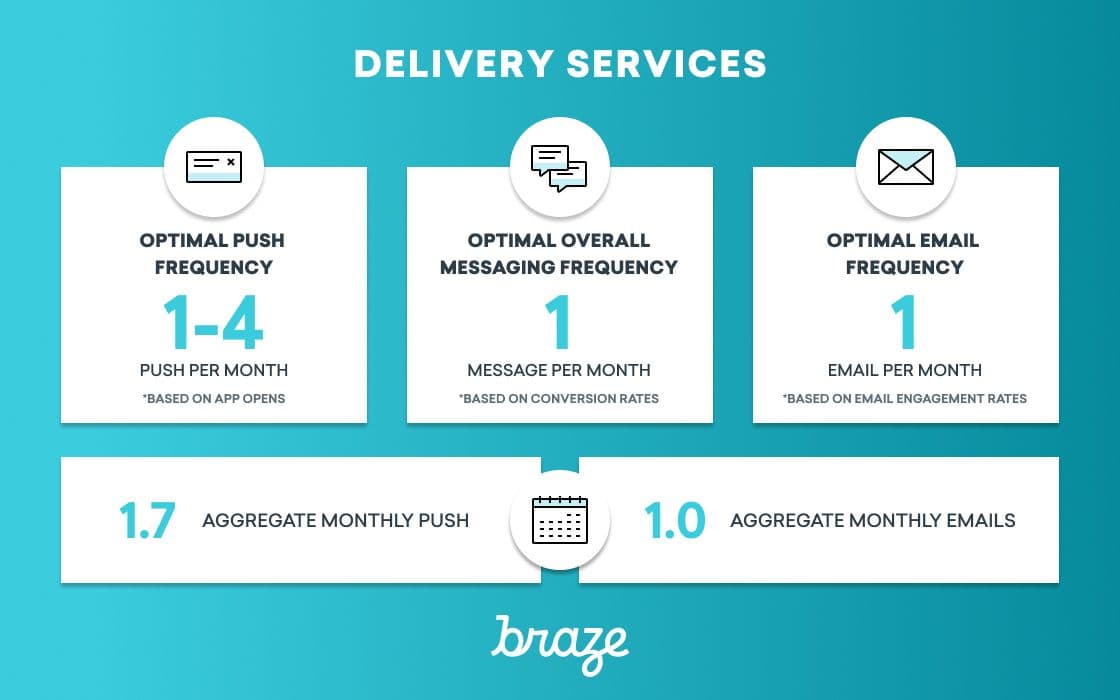
Delivery brands are right on target
Delivery brands are tasked with providing brilliant messaging experiences that can scale across a wealth of different cultures, languages, and time zones. That’s only possible if they craft thoughtful user journeys, which means send frequency is a key consideration.
Braze research found that the average delivery app sends nearly two push notifications per month, but that their push open rates remain comfortably above average when sending up to four pushes per month. That means most delivery brands are already right on target—and that the smart move for them is to consider leveraging more advanced push tools and tactics like push stories and rich push to create a standout user experience. For email, most delivery brands send between one and four emails per month, but engagement is highest at the low end, at around one email per month. But with the average office worker receiving 121 emails per day, delivery brands need to make sure their email messaging counts. The occasional promotion or local delivery recommendation with a nod toward your app could serve your brand well!
Industry #7: Transportation
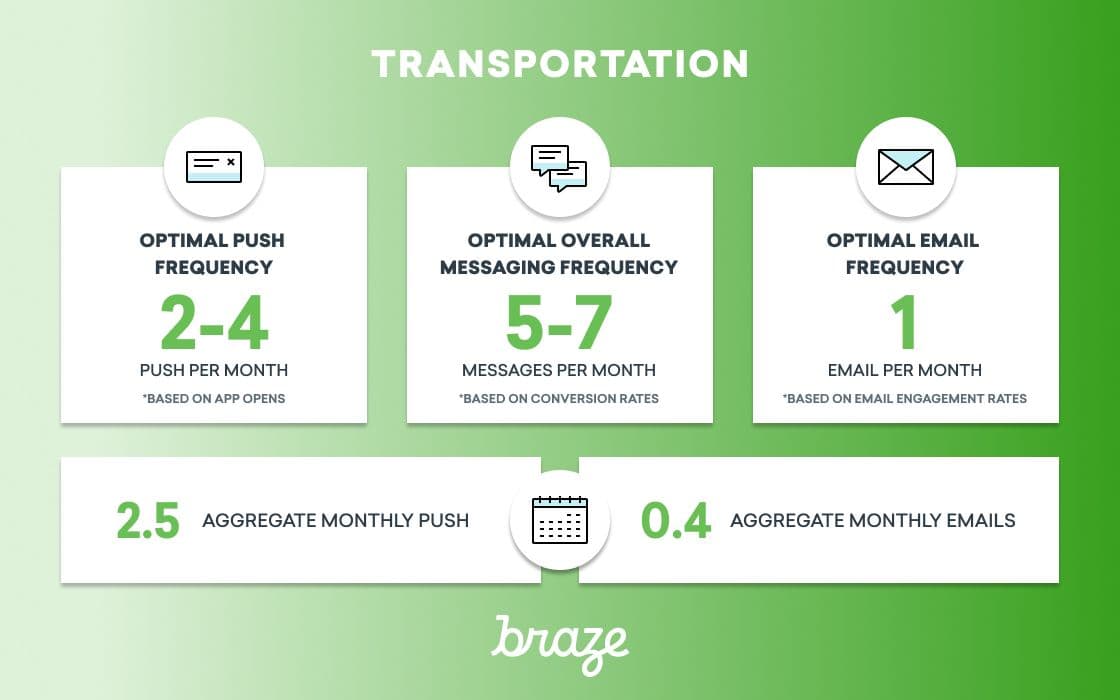
Transportation brands: Keep utilizing push, and work on a smooth cross-channel journey
Transportation brands tend to use push pretty effectively, with many companies in this space sending at the optimal frequency of 2-4 times per month per person. But while it makes sense that these brands send less email—what with many users of ride-, scooter-, or bike-sharing brands engaging primarily via mobile app—it’s still important to create a unified cross-channel customer journey.
Email represents a big opportunity for transportation brands—to offer deals and discounts, reconnect with lapsed users, confirm purchases and registrations, or share important information like fleet or weather updates. Plus, our research has found that conversion rates for this vertical rise as cross-channel frequency increases. So if you’re a transportation company and you’re not using email as part of your marketing mix, it may be time to start!
Industry #8: Finance
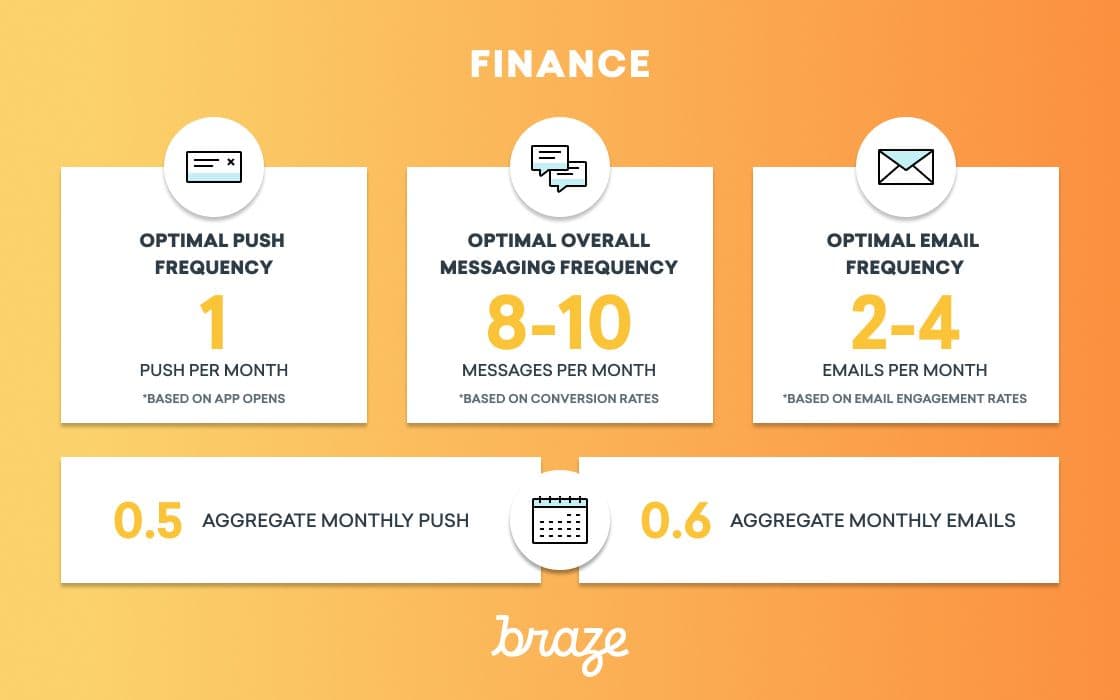
Financial services companies should only proactively message when necessary.
For finance brands, timely, informative notifications are key to demonstrating value—think fraud or low-balance alerts, interest rate updates, loan payment schedule tracking, credit card upgrades, and more. These messages only work if they’re extremely relevant, so it stands to reason that finance brands should reach out only when necessary. You see that approach reflected in the optimal push frequency for this industry, which is one push per month; smart brands in the space are focusing on conveying only essential info.
Finance brands tend to have a low email footprint, too, with the majority sending at most four emails per user per month. That said, frequency doesn’t seem to have a major impact on email engagement in this vertical, reinforcing the idea that it’s essential for finance brands to focusing on relaying valuable information, not sending messages to send messages.
Industry #9: Health
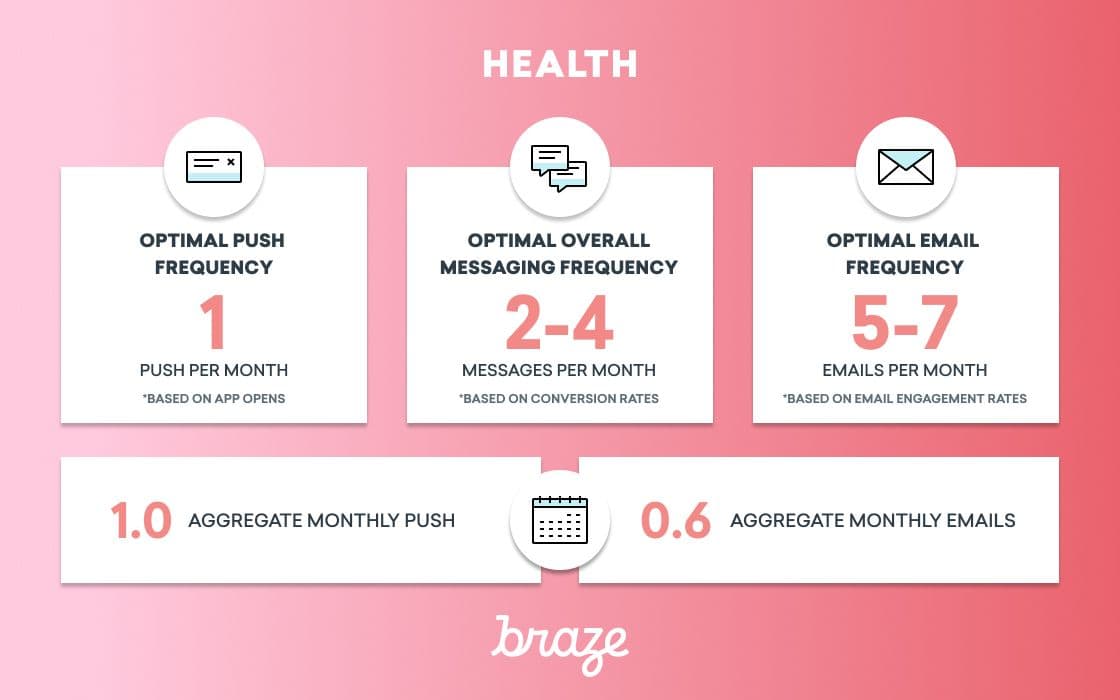
Health brands should prioritize email—and adjust their push content
While our research found that health brands who increase their email frequency see a positively sloping email engagement rate, the push engagement for companies in the health space declines quickly when they send more than one message per month. This may indicate that health apps aren’t hitting the mark yet when it comes to their push content—causing users to become annoyed with their messaging—or that customers prefer to have most of their engagement come through other channels.
Email, for instance, seems to have more upside for health brands, with optimal email send frequency clocking in significantly higher than the vertical’s average frequency. Consider upping your message frequency using email, but be thoughtful about what you send and make sure you’re testing to see whether more sends results in stronger engagement from your users before going all in.
Industry #10: Games
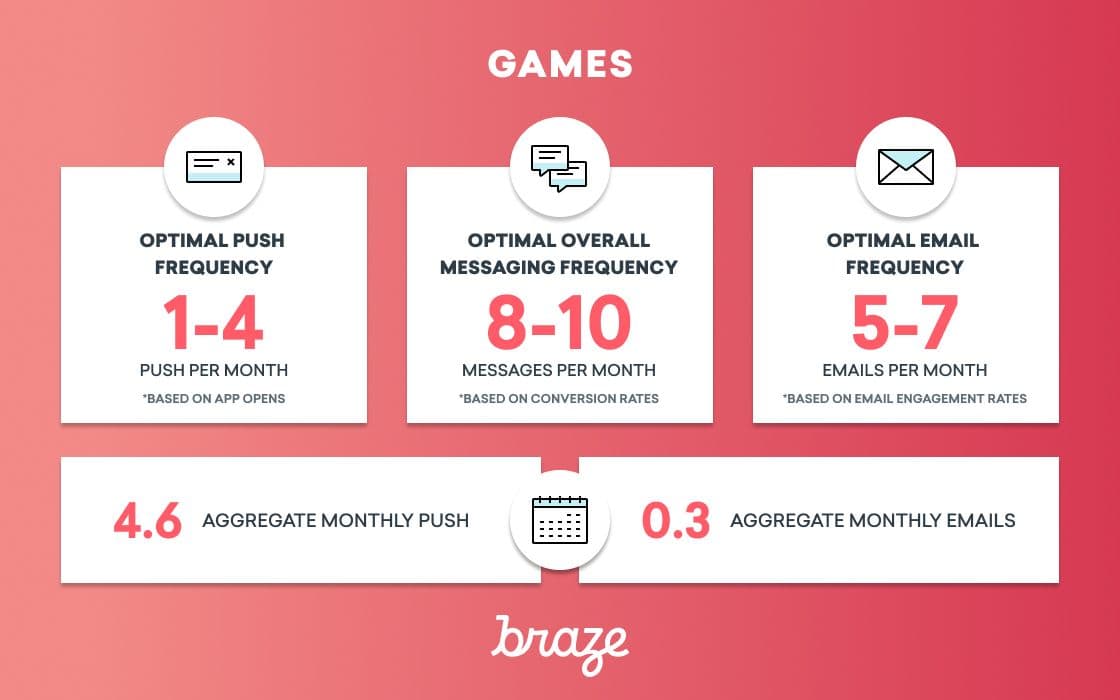
Gaming brands must stand out on a crowded home screen
Push is a critical channel for gaming brands. 62% of smartphone users install a game within a week of getting a new device, and in that crowded landscape, brands needs to both send at the optimal frequency—one to four monthly push, according to our data—but also ensure that these messages stand out. In other words, tools like rich push and push stories are now table stakes for creating brilliant user experiences.
With email, engagement peaks with a send frequency of 5-7 emails per month to each user. However, our research has found that most gaming brands are only sending between one and four emails per month. That suggests there may be an opportunity here for these brands to send more frequent emails to drive stronger user engagement and app opens.
Industry #11: Education
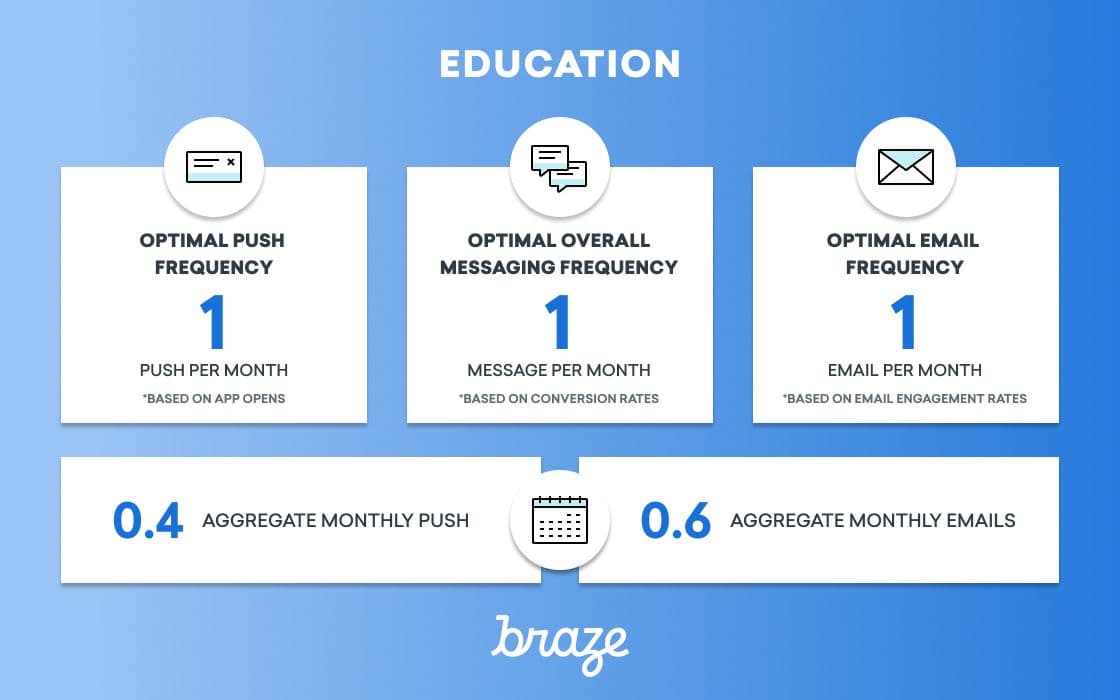
Education brands don’t send as many messages as you may think—but for a good reason
On the whole, education brands tend not to engage frequently with users; our research found that outreach maxes out at 4 messages per month each for both email and push. But since conversion rates for these messages steadily decrease as send frequency rises, that restraint is probably wise: The data suggests that these users prefer minimal contact (for instance, a gentle nudge for lapsing users). Nevertheless, education brands should pay attention to when and how they’re messaging—what they’re trying to accomplish with each channel, what kinds of communications they’re sending—so they can connect with their audience effectively to drive user engagement and conversions.
Industry #12: Lifestyle
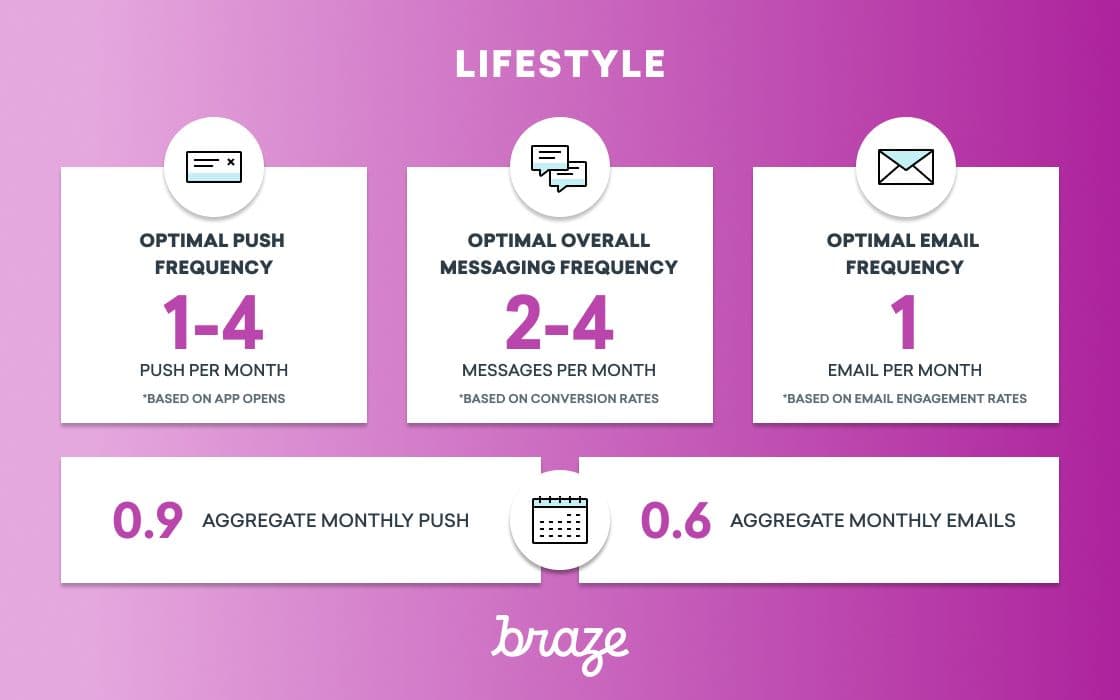
Lifestyle brands should be cross-channel strategizers
With push, the optimal frequency for lifestyle brands falls between one and four messages per month, then falls off quickly above that level. Given that dynamic, companies in this space would probably do well to aim for the high end of that range and connect with their audiences about once a week via push. When it comes to email, frequency doesn’t have much of an effect on engagement for lifestyle brands, but most—82%, to be exact—are sending one or fewer emails per month. That said, conversions show a clear peak at 2-4 cross-channel messager per user per month, so lifestyle apps should think seriously about utilizing a few channels in tandem to maximize returns.
Industry #13: Technology
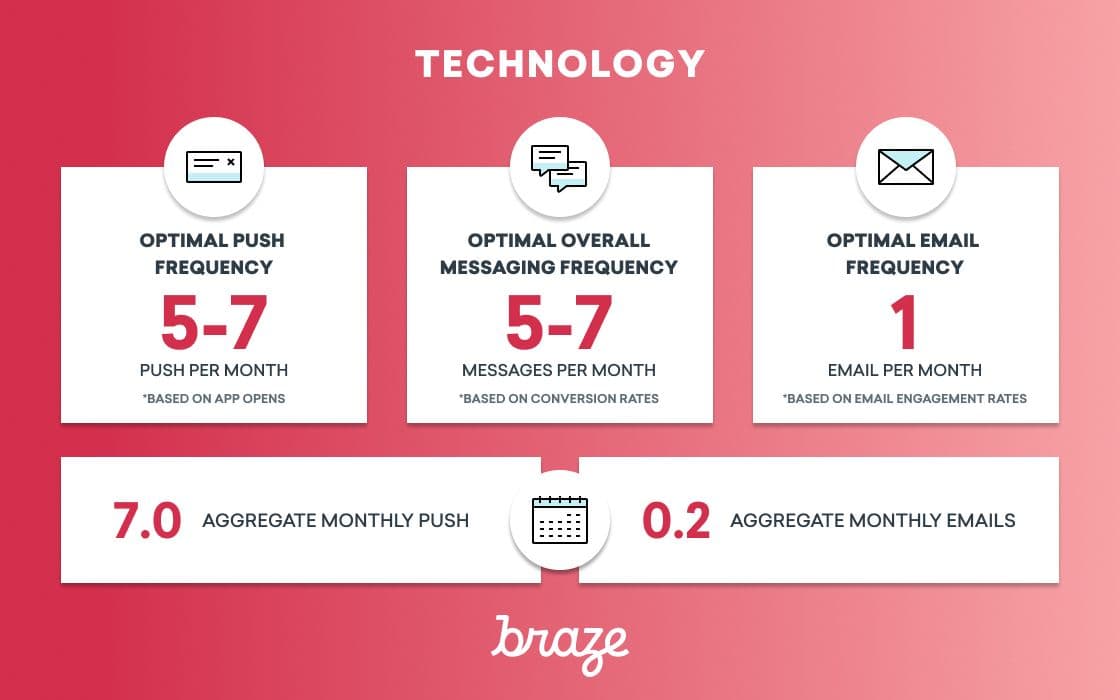
Tech companies should keep sending push—and refactor their email strategy
Technology brands send a surprising amount of push notifications, with an average push frequency that surpasses both ecommerce and gaming apps. That said, they’re rewarded for it; users in this vertical respond well to up to two pushes per week. On the email front, the smart move is one email per month, with most brands sending even fewer. That may indicate that tech brands are missing an opportunity to adjust their email content and cadence while increasing frequency—so, if that’s you, try A/B testing how users respond to different campaigns in this channel and see if it makes sense for you to send more email when there’s a clear value-add.
Interpreting The Data
Like we’ve said before: These are aggregate industry benchmarks. Your brand is not an industry; you have your own unique set of challenges, goals, obstacles and opportunities which will render some strategies useless and others critical. Make sure you use the above metrics as starting points for your own analyses and optimization—not as the final word.
That said: Use this information, go forth, and conquer!
Methodology
This analysis spans approximately 151 billion users and 534 billion messages sent over the past 2 years. These messages come from 674 companies across 20 different industries. The data were aggregated by month to reveal the average monthly send frequency of any given company that sent at least 1 monthly message per user within each industry, calculated as total messages divided by total users. Industry rates and user counts are aggregated monthly by company to create even comparison periods.
Related Tags
Be Absolutely Engaging.™
Sign up for regular updates from Braze.
Related Content
View the Blog
How AI Decisioning Transforms Marketing (A Complete Guide)

Team Braze

AI decisioning cheat sheet: How to crawl/walk/run with BrazeAI Decisioning Studioᵀᴹ

Team Braze

A day in the life of a data scientist on the BrazeAIᵀᴹ forward-deployed engineering team
